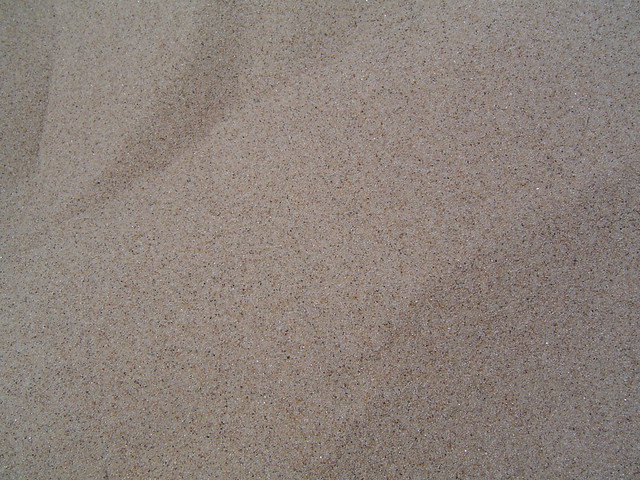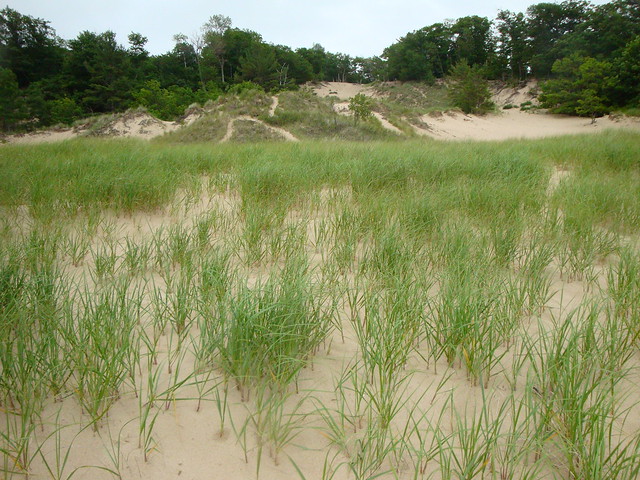In the process of putting on their shoes the kids dump little piles of sand on the kitchen floor. It's on the car seats. Sometimes it gets into food with one or two gritty bites.
The sand invasion is because it's summer in West Michigan, and we've been heading down to the Lake Michigan beach several times per week. Today we made another trip to Hoffmaster State Park campground beach and let the kids splash around in Little Black Creek that flows directly into Lake Michigan. It winds a constantly shifting trail through the sugar sands until it spills out into the Big Lake. It's shallow and warm, with minnows to chase, and the kids love to splash in it and build sand castles. We climb up the dunes and run down them into the lake and the stream and in the process get sandy...and carry the sand on our wet skin and swimsuits to the car, to the house, to the bedrooms, to the laundry. Sand everywhere...
West Michigan sand is a very fine sand. Here's a close-up picture I took of some sand on the beach at Lake Harbor Park. I should have put a dime down for scale:

You can see it's a fine grained sand, over 90% silica. That's quartz. And on a hot summer day, when the moisture is just right it squeaks when you walk on it. When I moved to Iowa, I was shocked to learn sand didn't squeak everywhere. I just assumed it did. It's a phenomenon known as "singing sands"
Here's a good example of Lake Michigan sand squeaking under foot:
And there's tons of it stretching along the West Michigan coast for hundreds of miles, piling up into dunes...

and

It's all coming in from Lake Michigan, pushed out and up over the course of thousands of years. The sandy beaches come from the Lake. So it shouldn't be surprising that there's no muck on the bottom of the Eastern side of Lake Michigan. Just sand. Walk into Lake Michigan, and you're walking into a soft, sandy bottomed lake, looking down through clear, blue water at tiny ridges of white sand sculpted by the motion of the water.
The Great Lakes ecosystem isn't confined to the water itself. The Lakes have shaped the land and the weather around them, and have created unique ecosystems. The sandy dune habitats are one such system, formed over ten thousand years as the lakes push more and more sand up. The dunes form a series of dune ridges all along the 300+ miles of West Michigan coast, usually between one and four successive ridges extending from the beach itself. The dunes move and shift and grow week to week, year to year. Today we climbed a dune and could see where it has moved eastward. Trees stood on scraggly roots on the side near the lake, or had fallen down as the ground disappeared beneath them. On the inland side, some wide, once tall oaks had been covered near to their tops. Entire homes, and even old towns have been known to have been swallowed up by shifting dunes.
Almost as much as the Lake itself, it's these dune ridges I think about when I imagine the beauty of the lakes, and they're all made of this squeaking silica sand that seems to come from the lake in endless supply.
2 comments:
Thanks for reminding me of the singing sands! I remember beach breakfasts at Norton Township park -- now Hoffmaster State Park, I guess -- Fried egg and bacon sandwiches on rusk buns. They weren't authentic without that crunch of sand. We used to dig a hole in the wet sand to bury the watermelon which would be ice cold when we dug it up -- if we didn't forget where we dug.
Many thanks for the pictures and memories. and good luck with the wind farms.
--ml
I was born in South Haven in 1946and spent many days on the beaches there, and at Covert Park. When I got tired of frolicking with the breakers as far out as I dared, or got cold, I'd plod up to a bare cleft in the dune under the old Monroe house above the south beach. I'd wrap up in the beach towel, sit facing the water, and get warm, gazing out over the waves, feeling the peace of a holy place.
Susan Cook
Ypsilanti
Post a Comment